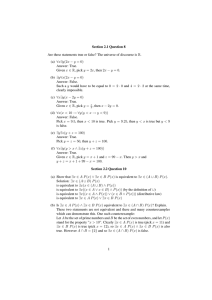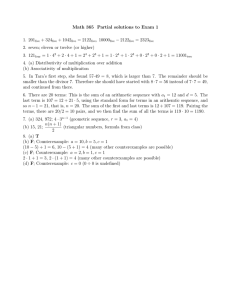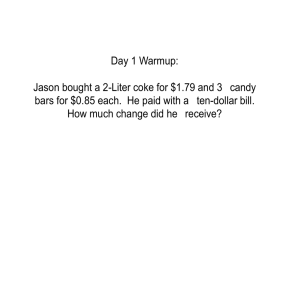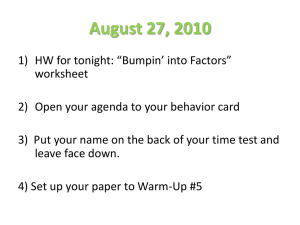Math 365 Partial solutions to Exam 2
advertisement
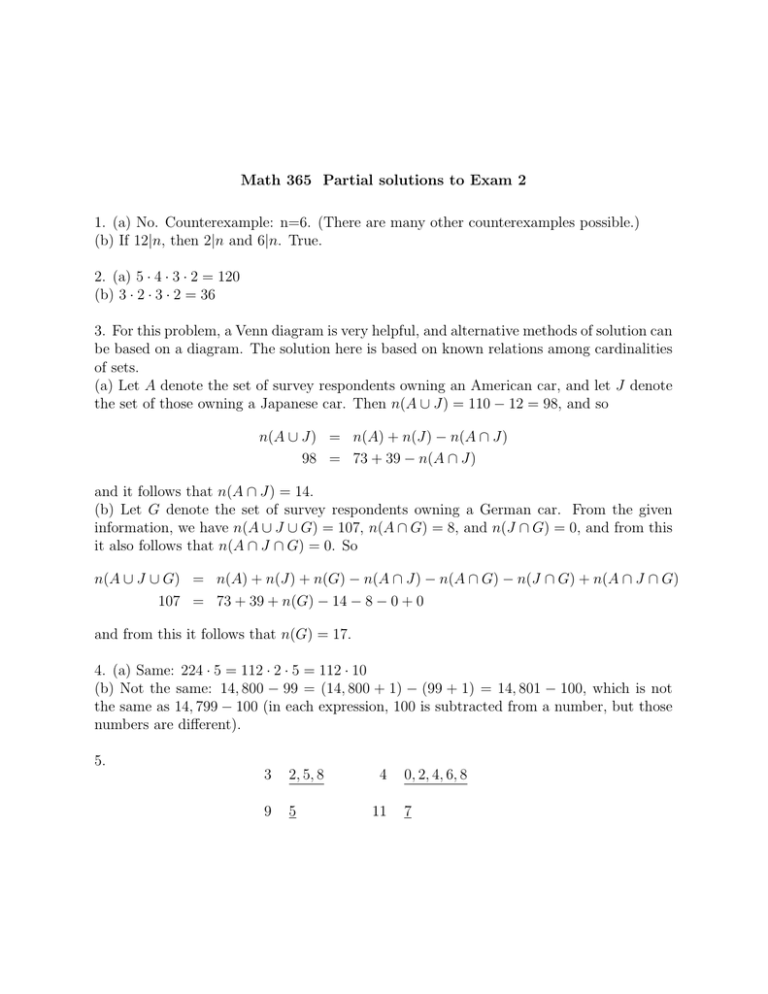
Math 365 Partial solutions to Exam 2
1. (a) No. Counterexample: n=6. (There are many other counterexamples possible.)
(b) If 12|n, then 2|n and 6|n. True.
2. (a) 5 · 4 · 3 · 2 = 120
(b) 3 · 2 · 3 · 2 = 36
3. For this problem, a Venn diagram is very helpful, and alternative methods of solution can
be based on a diagram. The solution here is based on known relations among cardinalities
of sets.
(a) Let A denote the set of survey respondents owning an American car, and let J denote
the set of those owning a Japanese car. Then n(A ∪ J) = 110 − 12 = 98, and so
n(A ∪ J) = n(A) + n(J) − n(A ∩ J)
98 = 73 + 39 − n(A ∩ J)
and it follows that n(A ∩ J) = 14.
(b) Let G denote the set of survey respondents owning a German car. From the given
information, we have n(A ∪ J ∪ G) = 107, n(A ∩ G) = 8, and n(J ∩ G) = 0, and from this
it also follows that n(A ∩ J ∩ G) = 0. So
n(A ∪ J ∪ G) = n(A) + n(J) + n(G) − n(A ∩ J) − n(A ∩ G) − n(J ∩ G) + n(A ∩ J ∩ G)
107 = 73 + 39 + n(G) − 14 − 8 − 0 + 0
and from this it follows that n(G) = 17.
4. (a) Same: 224 · 5 = 112 · 2 · 5 = 112 · 10
(b) Not the same: 14, 800 − 99 = (14, 800 + 1) − (99 + 1) = 14, 801 − 100, which is not
the same as 14, 799 − 100 (in each expression, 100 is subtracted from a number, but those
numbers are different).
5.
3
2, 5, 8
9
5
4
11
0, 2, 4, 6, 8
7
6.
97 is prime (check it is not divisible by 2, 3, 5, 7, and this suffices, as
and these are all the prime numbers less than 10)
√
97 <
√
100 = 10,
187 is composite (as it is divisible by 11)
27 − 1 is prime (it
√ to 127, and again one can check divisibility by primes less
√ is equal
than or equal to 127 < 144 = 12)
19 · 23 + 23 · 89 is composite (since 23 is a factor of each term, it is a factor of the number,
specifically, the number is equal to 23 · (19 + 89) = 23 · 108)
19! + 17 is composite (Since 19! = 19 · 18 · 17 · 16 · · · 3 · 2 · 1, the number 17 is a factor of
each term of the number, specifically, the number is equal to 17 · (19 · 18 · 16 · · · 3 · 2 · 1 + 1))
7. (a)
91
35
21
14
=
=
=
=
35 · 2 + 21
21 · 1 + 14
14 · 1 + 7
7·2
So GCD(91, 35) = 7 (the last nonzero remainder above)
91 · 5 · 7
91 · 35
=
= 91 · 5 = 455
(b) LCM(91, 35) =
7
7
8. (a) True
(b) False. Counterexample: A = {1, 2, 3}, B = {3, 4, 5}, C = {3, 4}. Then A ∩ B =
{3} = A ∩ C, but B 6= C. (Many other counterexamples are possible.)
(c) False. Counterexample: n = 21 (n is divisible by 3, but each digit of n is not)
(d) False. Counterexample: a = 2, b = 4, d = 8 (then d divides 2 · 4 = 8 but d does
not divide 2 nor 4)
(e) True.
